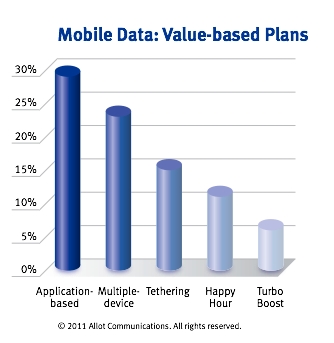Telefónica Europe has described its Q3 results as “solid”, after growing its total customer base 5% year on year, seeing revenues decline by between 0.4-0.8% in organic terms, and total ARPU decline 5.7% year on year in the first nine months, dropping 6.7% in the third quarter.
Across Telefonica’s operating units, roughly the same picture pertains. Voice revenues and, in some cases, traffic, declines (except in Germany). Data shows strong growth, but not enough to stave off ARPU declines.
The operator now has 57.8 million customers across all its European operations (excluding Spain), with mobile broadband customers now representing 29% of the total base, an increase of 5% year on year — a number that has contributed to a rise in total mobile data revenues of 12.3%.
Mobile data revenues (including P2P SMS) accounted for 41% of all mobile service revenues in the first nine months of 2011, against 36% in the first nine months of 2010. Non-P2P SMS data revenues grew 36%, to account for 43% of all mobile data revenues.
Telefonica said the growth in non-SMS data revenues were as a result of the “successful” deployment of tiered pricing. Although data continues to grow greatly as a share of revenues, data ARPU grew by a more modest 6%, from €10.1 for the first nine months of 2010 to €10.5 for the first nine months of 2011.
In the UK, where O2 now has 22.2 million customers, plus an additinal 2.8 million through its JV with Tesco Mobile, mobile voice traffic deceased 8% year on year, with data traffic increasing 22%. Total ARPU declined 5.7% year on year.
In Germany, where O2 has 18.1 million customers, mobile voice traffic was up 10% and data greatly up, rising 51% in the first nine months, Yet ARPU declined 8.7% year on year.
In the UK and Germany Telefonica said that MTR cuts were partly or mostly responsible for falling ARPU.
In the Czech Republic, ARPU decreased 9.4% year on year, again affected by MTR cuts,
In Ireland total ARPU declined 9.5%, although that would have been a 2.3% decline excluding MTR cuts, the operator said. Data revenues grew 8,2% in the first nine months, although that was “more than offset” by declining voice revenues.
Earlier this week Vodafone released results for the first six months of its financial year (to 30 September) showing that at Group level results were slightly up, although the situation in Spain, Italy and Greece offset European gains in the UK and Germany.
Like Telefonica, the operator reported a rise in data revenues, with data revenue up 23.8% year-on-year to £3.1 billion, and now representing 14% of Group service revenue.
Voice revenues were down from £13,7 billion to £13.3 billion to for the six months to September 30. Messaging revenue rose slightly, from £2.4 billion to £2.6 billion, and fixed line revenues grew from £1.6 billion to £1.8 billion.
In Europe, service revenue was down 1.3%) in H1, with a marginally better performance in Q2 than in Q1. In northern Europe, service revenue growth in Q2 improved in the UK (+2.5%) and the Netherlands (+4.2%), and remained steady in Germany (+0.1%). In southern Europe, Spain showed a sequential improvement in its service revenue trend to -9.3% (Q1 -9.9%).
Growth in Italy deteriorated from -1.5%) in Q1 to -3.0%) in Q2, reflecting a decline in consumer confidence and an incremental impact of 0.4 percentage points from MTR cuts. Turkey continued to grow strongly in Q2 (+24.0%).
Europe EBITDA was flat year-on-year at £5.6 billion, with the EBITDA margin down 1.0 percentage point. Vodafone said that this decline was almost entirely driven by a 6.1 percentage point margin decline in Spain as a result of price reductions and the macroeconomic environment.






Adding smarts to buck the trend
Vodafone and Telefonica’s results showed the nature of the Tier One operator beast. They are fighting teeth and nail to grow data revenues, and it is a fight that they are largely winning. But this growth is not enough to offset reductions in service revenues from voice, and much lower growth from SMS revenues.
Overall, therefore, revenues are flat or declining by single digits, with ARPUs also weakening.
Across Telefonica’s operating units, roughly the same picture pertains. Voice revenues and, in some cases, traffic, declines (except in Germany). Data shows strong growth, but not enough to stave off ARPU declines.
In the UK, for example, where O2 now has 22.2 million customers, plus an additinal 2.8 million through its JV with Tesco Mobile, mobile voice traffic deceased 8% year on year, with data traffic increasing 22%. Total ARPU declined 5.7% year on year.
(In Germany, where O2 has 18.1 million customers, mobile voice traffic was up 10% and data greatly up, rising 51% in the first nine months, Yet ARPU declined 8.7% year on year.)
Vodafone too showed overall service revenues under threat, although it took a more geographical view, having greater exposure to the situations in Italy and Greece than Telefonica.
Both operators pointed the finger at MTR cuts, and also roaming tariff cuts, in Telefonica’s case. Yet it’s clear it’s not just about tariffs and termination rates. Traffic is also down, and you might expect it to be up given the cuts in rates. Separate data from the French regulator seemed to suggest that in that market the ongoing growth in SMS volumes could also be coming to a close.
So it was a good time for Tellabs to have commissioned a report from analyst firm STL, looking at the nature of the mobile operator business. (we’ll have a fuller report on this analysis next week on Mobile Europe)
STL’s thesis is that operators currently look like utility businesses, in terms of their cash return on investment. If operators want to bump up that metric – put simply, the amount of cash they generate in return for the amount invested in the business – they need to become smart. If they want to bump up their CROI a little bit, they can make their networks “smart”, and if they want to become highly cash generative, they can add in smart services and support for smart services on top of that.
There are some “quick wins” here, such as network investment and a bit of “housekeeping”. But the greater opportunity is in developing the means to deploy those smart services – things such as differentiated pricing and charging, making network and other APIs available, and developing personalised and differentiated services.
A survey of operators by STL showed that the operators themselves simultaneously thought that these sort s of steps were the most important to them developing a “smart services” strategy. Unfortunately, the operators also thought that many of the most important strategic decisions were also the hardest to implement.
So they are in a tough place – and he “smart services” bet is a long term one. Telefonica was described to me as the “poster child” for the smart approach – with its BlueVia project to work with developers using network and service APIs, with its investment in Jajah and willingness to look at working with third party service providers.
Yet Telefonica, as we have seen from above, is still only nudging its data ARPUs forwards, and certainly not enough to offset the voice decline.
One thing is certain, though. If operators don’t take at least the step to the smart network, so that they can operate the best, highest capacity, most flexible and cost-efficient network that they can, then they are really doomed.
With that in mind all the associated smart network decisions, such as in-network CDNs, pico and small cell underlays, WiFi offload and smarter backhaul are all more relevant than ever. And to influence the debate on all of that, please take our all-new 2012 survey! Details below.
Keith Dyer
Editor
Mobile Europe
TAKE OUR “ONES TO WATCH” 2012 SURVEY